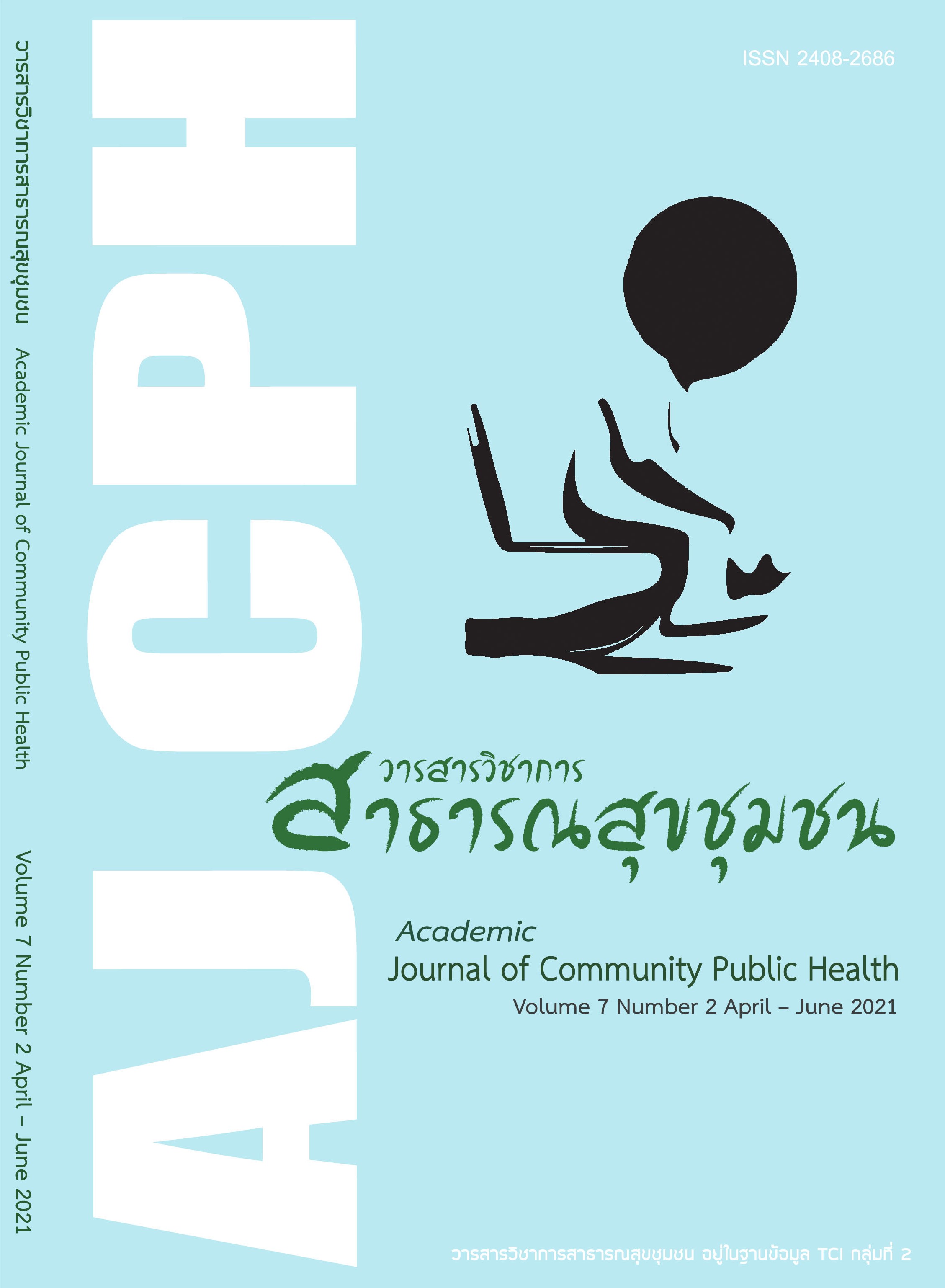พฤติกรรมการบริโภคเครื่องดื่มให้พลังงานของวัยรุ่นภาคตะวันออก
คำสำคัญ:
เครื่องดื่มให้พลังงาน, ทฤษฎีพฤติกรรมตามแผน, วัยรุ่นบทคัดย่อ
การศึกษานี้มีวัตถุประสงค์ เพื่อศึกษาพฤติกรรมการบริโภคเครื่องดื่มให้พลังงานและปัจจัยที่มีอิทธิพลต่อพฤติกรรมการบริโภคเครื่องดื่มให้พลังงานของวัยรุ่นในภาคตะวันออก กลุ่มตัวอย่าง ได้แก่ วัยรุ่นที่กำลังศึกษาระดับปริญญาตรี ในภาคตะวันออก จำนวน 989 คน ทำการเก็บข้อมูลโดยใช้แบบสอบถามที่พัฒนาขึ้น วิเคราะห์ข้อมูลโดยใช้สถิติพรรณนา ค่าสัมประสิทธิ์สหสัมพันธ์แบบเพียร์สัน และการถดถอยพหุแบบขั้นตอนเพื่อหาความสัมพันธ์และอิทธิพลของปัจจัยต่อพฤติกรรมการบริโภคเครื่องดื่มให้พลังงาน วิเคราะห์ความแปรปรวนพหุคูณเปรียบเทียบความแตกต่างระหว่างเพศ ผลการศึกษา พบว่า กลุ่มตัวอย่างส่วนใหญ่ร้อยละ 73.7 เป็นเพศหญิง มีอายุ 18 ปีขึ้นไป (ร้อยละ 61.2) กลุ่มตัวอย่างมีพฤติกรรมการบริโภคเครื่องดื่มให้พลังงานเป็นประจำ (บริโภค ≥4 วันต่อสัปดาห์) ได้แก่ น้ำเครื่องดื่มชูกำลัง กาแฟ น้ำอัดลม และชา ร้อยละ 73.0, 65.7, 44.9 และ 36.3 ตามลำดับ เจตคติ การคล้อยตามกลุ่มอ้างอิง และการรับรู้การควบคุมพฤติกรรม มีความสัมพันธ์กับพฤติกรรมการบริโภคเครื่องดื่มให้พลังงาน อย่างมีนัยสำคัญทางสถิติที่ระดับ 0.01 (r = 0.393, 0.374 และ0.363 ตามลำดับ) เจตคติ (β = .228, p < .001) การคล้อยตามกลุ่มอ้างอิง (β = .243, p < .001) และการรับรู้การควบคุมพฤติกรรม (β = -.236, p < .001) สามารถร่วมกันทำนายพฤติกรรมการบริโภคเครื่องดื่มให้พลังงานได้ร้อยละ 26.6 (R2 = .266, p < .001) และเพศหญิงมีพฤติกรรมการบริโภคเครื่องดื่มให้พลังงานสูงกว่าเพศชายอย่างมีนัยสำคัญทางสถิติ (p < 0.001) ดังนั้น จึงควรมุ่งเน้นการส่งเสริมให้วัยรุ่นมีเจตคติ การคล้อยตามกลุ่มอ้างอิง และการรับรู้ความสามารถในการควบคุมพฤติกรรมของตนเอง เพื่อให้วัยรุ่นมีพฤติกรรมการบริโภคเครื่องดื่มให้พลังงานที่เหมาะสม
เอกสารอ้างอิง
Harris JL, Munsell CR. Energy drinks and adolescents: what's the harm?. Nutr Rev. 2015;73(4):247-257.
Itany M, Diab B, Rachidi S, et al. Consumption of energy drinks among Lebanese youth: a pilot study on the prevalence and side effects. Int J High Risk Behav Addict. 2014;3(3):e18857.
Musaiger A, Zagzoog N. Knowledge, attitudes and practices toward energy drinks among adolescents in Saudi Arabia. Glob J Health Sci. 2013;6(2):42-46.
Seifert SM, Schaechter JL, Hershorin ER, Lipshultz SE. Health effects of energy drinks on children, adolescents, and young adults [published correction appears in Pediatrics. 2016 May;137(5):null]. Pediatrics. 2011;127(3):511-528.
Chrysant SG, Chrysant GS. Cardiovascular complications from consumption of high energy drinks: recent evidence. J Hum Hypertens. 2015;29(2):71-76.
Wassef B, Kohansieh M, Makaryus AN. Effects of energy drinks on the cardiovascular system. World J Cardiol. 2017;9(11):796-806.
Al-Shaar L, Vercammen K, Lu C, Richardson S, Tamez M, Mattei J. Health Effects and Public Health Concerns of Energy Drink Consumption in the United States: A Mini-Review. Front Public Health. 2017;5:225.
Mattioli AV, Manenti A, Bonetti LR, Farinetti A. Energy drinks and obesity: Preliminary results from a preclinical study. Anatol J Cardiol. 2018; 19(6) :422.
Attila S, Çakir B. Energy-drink consumption in college students and associated factors. Nutrition. 2011;27(3):316-322.
Heckman M, Sherry K, Mejia D, Gonzalez E. Energy drinks: an assessment of their market size, consumer demographics, ingredient profile, functionality, and regulations in the United States. Compr Rev Food Sci Food Saf 2010;9(3):303–17.
Babu KM, Church RJ, Lewander W. Energy drinks: the new eye-opener for adolescents. Clin Pediatr Emerg Med. 2008;9(1):35–42.
Ibrahim NK, Iftikhar R. Energy drinks: Getting wings but at what health cost?. Pak J Med Sci. 2014;30(6):1415-1419.
สำนักงานสถิติแห่งชาติ. รายงานการสำรวจพฤติกรรมการบริโภคอาหารของประชากร พ.ศ. 2560. กรุงเทพฯ. กองสถิติพยากรณ์ สำนักงานสถิติแห่งชาติ ศูนย์ราชการเฉลิมพระเกียรติ 80 พรรษาฯ; 2561.
Cohen, J. Statistical Power Analysis for the Behavioral Sciences (2nd ed.). New York, NY: Academic Press; 1988.
West DS, Bursac Z, Quimby D, et al. Self-reported sugar-sweetened beverage intake among college students. Obesity (Silver Spring). 2006;14(10):1825-1831.
Rı´os JL, Betancourt J, Paga´n I, Fabia´n C, Cruz SY, Gonza ´lez AM, Gonza´lez MJ, Rivera-Soto WT, Palacios C. Caffeinated-beverage consumption and its association with socio-demographic characteristics and self-perceived academic stress in first and second year students at the University of Puerto Rico Medical Sciences Campus (UPR-MSC). P R Health Sci J. 2013;32:95–100.
Hasan, T., Sultana, M., Shill, L.C., & Sultana, S. Consumption of energy drink and associated factors: Experience from students of public university in Bangladesh. Nutrition & Food Science 2019;50, 131-142.
Thorlton J, Collins WB. Underlying Beliefs Associated With College Student Consumption of Energy Beverages. West J Nurs Res. 2018;40(1):5-19.
Zoellner J, Estabrooks PA, Davy BM, Chen YC, You W. Exploring the theory of planned behavior to explain sugar-sweetened beverage consumption. J Nutr Educ Behav. 2012;44(2):172-177.
Ajzen, I. From intentions to actions: A theory of Planned Behavior. In: J. Kuhl and J.Beckmann (Eds.). Action-Control: From cognition to behavior (pp. 11-39). Heidelberg, Germany: Springer; 1985.
Ajzen, I. The Theory of Planned Behavior. Organizational Behavior & Human Decision Processes 1991; 50(2),179-211.
Malinauskas BM, Aeby VG, Overton RF, Carpenter-Aeby T, Barber-Heidal K. A survey of energy drink consumption patterns among college students. Nutr J. 2007; 6:35. Published 2007 Oct 31.
Cabezas-Bou E, De León-Arbucias J, Matos-Vergara N, et al. A Survey of Energy Drink Consumption Patterns among College Students at a Mostly Hispanic University. J Caffeine Res. 2016;6(4):154-162.



